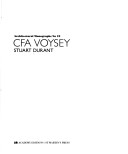Charles Francis Annesley Voysey, 1857-1941, had an immense reputation in the 1890s and early years of this century. His houses, his furniture and his textiles were greatly admired and widely imitated. But with the outbreak of World War I his architectural career came to an end. He eked out a rather precarious existence, designing textiles and wallpapers, as he faded from the public's memory. In the 1930s Voysey was rediscovered by John Betjeman, the architect writer Raymond McGrath and Nicholas Peusner, McGrath and Peusner treated Voysey as if he was a modern, born before his time. He was nothing of the sort; he was a great 19th-century architect, the greatest Victorian domestic architect. Voysey emerged as an architect with a distinctive style in the 1890s. His work was widely publicised in avant garde periodicals like "The Studio" as well as in Continental journals. Intellectuals quickly seized upon the idea of the Voysey House, H.G. Wells commissioned a Voysey House. Other Voysey clients included well known writers, publishers and artists. Voysey, unlike many architects of his day, still has much to teach us.
His architecture is gentle, eminently civilized, but never dull or timid. His houses were built of simple materials, they related perfectly to sites. Voysey, as an architect, was a green.
- ISBN10 1854900323
- ISBN13 9781854900326
- Publish Date 16 April 1992
- Publish Status Transferred
- Out of Print 3 April 2009
- Publish Country GB
- Publisher John Wiley and Sons Ltd
- Imprint Wiley-Academy
- Format Paperback
- Pages 144
- Language English
